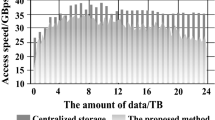Abstract
Aiming at the problems of high energy consumption, small amount of stored data, large standard deviation of storage space, high failure rate of storage nodes and poor quality of data storage in existing multimedia key area synchronous storage methods, a machine learning based multimedia key area synchronous storage method is proposed. Using genetic algorithm to calculate the distance between data in multimedia critical area and cluster center, and redistribute cluster set, K-Mean is realized by M-R parallel computing model. Different amounts of data are allocated to the clustered sample data storage nodes to complete the synchronous storage of multimedia key area data. The experimental results show that compared with other methods, under the network regulation of 2800 m × 800 m, the storage energy consumption of the proposed method is in the range of 10 × 103NJ-1250 × 103NJ, and the storage energy consumption is low; The maximum number of data storage is 570, and the amount of stored data is large; the standard deviation of data storage space in the key area of multimedia changes within the range of 1.3–4, and the standard deviation of storage space is small. The proposed method lays a foundation for the further development of data storage technology.








Similar content being viewed by others
References
El-Rabiaey MA, Areed NFF, Obayya SSA (2016) Novel plasmonic data storage based on nematic liquid crystal layers. J Lightwave Technol 16(7):3726–3732
Han JF (2016) Research on low load storage method of massive data in cloud computing environment. Comput Simul 4(3):390–394
Hu JW, Wu D, Liu N (2017) Research on the method of passive data storage in link layer optical Fiber network. J Inner Mongolia Normal Univ (Natural Science Edition) 3(2):456–460
Huang BH, Wang TJ, Jia FW (2016) Encrypting storage and query method for numeric data in database. Comput Eng 7(6):123–128
Li Y, Gai K, Qiu L et al (2016) Intelligent cryptography approach for secure distributed big data storage in cloud computing. Inf Sci C:103–115
Nobukawa T, Nomura T (2017) Digital super-resolution holographic data storage based on hermitian symmetry for achieving high areal density. Opt Express 2(1):1326
Varan B, Yener A (2016) Delay constrained energy harvesting networks with limited energy and data storage. IEEE J Select Areas Commun 5(2):1550–1564
Wang J, Huang CG, Wang J et al (2016) Research of distributed storage method for agricultural sci- entific data. Comput Eng Applic 11(6):248–253
Wu C, Yoshinaga T, Ji Y et al (2017) A reinforcement learning-based data storage scheme for vehicular ad hoc networks. IEEE Trans Veh Technol 99(6):1–1
Xu YH, Zhu EG, Zhao R et al (2017) Unstructured data storage method for electricity information based on MongoDB index. Proc CSU-EPSA 9(1):93–97
Yang XY (2016) Research on key Technologies of Distributed Storage Based on Hadoop's massive data. Autom Instrum 10(3):166–167
Yang CT, Shih WC, Huang CL et al (2016) On construction of a distributed data storage system in cloud. Computing 12(8):93–118
Yang DR, Chen Y, Liu SY et al (2017) Research on fault tolerant strategy optimization of storage system for the healthcare big data. J Chin Acad Electron Inform Technol 5(1):546–550
Yazdi SMHT, Han MK, Gabrys R et al (2017) Mutually uncorrelated primers for dna-based data storage. IEEE Trans Inf Theory 99(2):1
Zhao D, Katsouras I, Asadi K et al (2016) Retention of intermediate polarization states in ferroelectric materials enabling memories for multi-bit data storage. Appl Phys Lett 23(5):1040–1090
Acknowledgments
This work was supported by NSFC “The Research on Personalized APP Graph based Recommendation Model Importing user’s attention” (No. 61772156).
Author information
Authors and Affiliations
Corresponding author
Additional information
Publisher’s note
Springer Nature remains neutral with regard to jurisdictional claims in published maps and institutional affiliations.
Rights and permissions
About this article
Cite this article
Chen, L. Analysis of synchronized storage method for multimedia key areas based on machine learning. Multimed Tools Appl 80, 22685–22700 (2021). https://doi.org/10.1007/s11042-019-07752-5
Received:
Revised:
Accepted:
Published:
Issue Date:
DOI: https://doi.org/10.1007/s11042-019-07752-5




